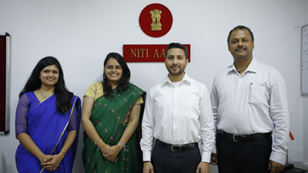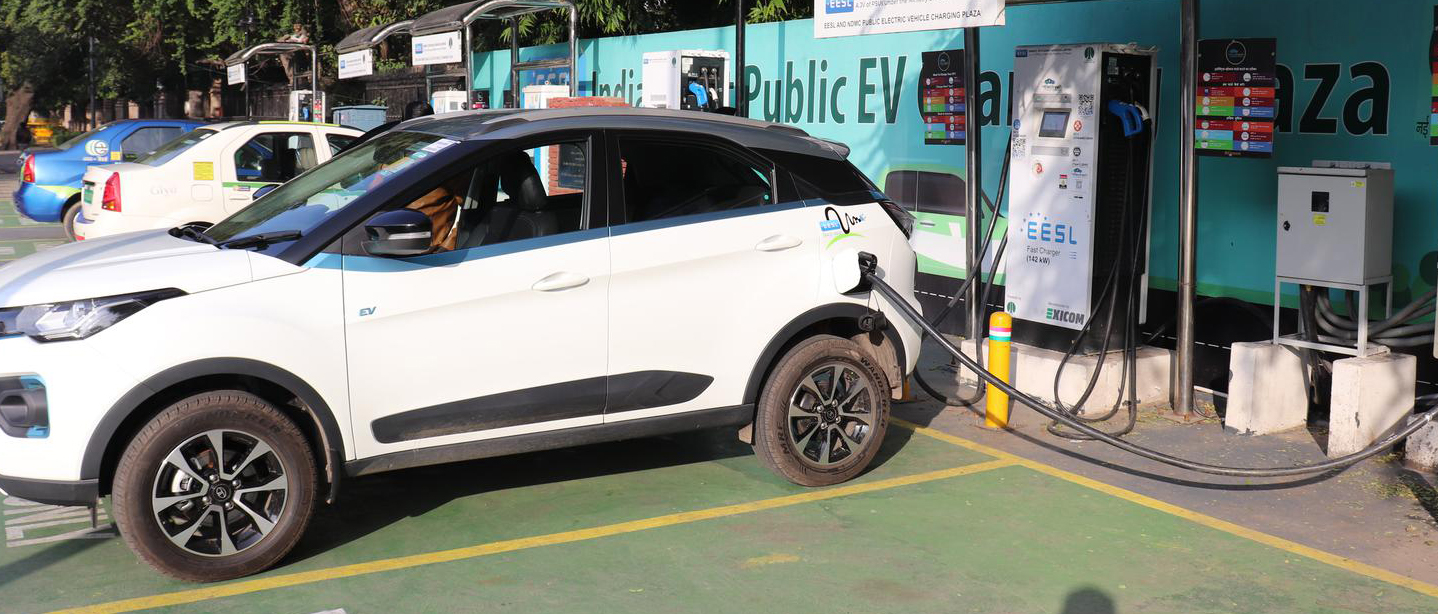World EV Day 2022: Interview with Randheer Singh, NITI Aayog
Electric Mobility Team, Shakti Sustainable Energy Foundation, September 15, 2022

Randheer Singh with members of the Shakti
Electric Mobility team
Major countries across the world are pledging to switch to electric mobility, and India too is taking steps to accelerate this transition. On the occasion of World EV Day 2022, we speak to Randheer Singh, Director, Electric Mobility, NITI Aayog on charging infrastructure, EV financing and battery use.
With India’s commitment to Net-zero by 2070, we would like to know about decarbonisation of transport sector in India.
The transport sector in India is a major contributor to air pollution, especially in urban India. Our transport is highly dependent on fossil fuels and hence we need to shift to cleaner vehicles such as EVs. Urban transportation demand is increasing with increase in GDP and urbanisation. There is growing importance to making this sector more efficient. By switching to EVs, India can not only meet climate commitments, but also reduce air pollution, improve public health, reduce oil dependency and have greater energy security.
EVs still have a few challenges for adoption the most important one being the high upfront cost especially for 4-wheeler and above segments. How can India develop an EV finance mechanism?
India needs to develop an EV ecosystem that brings multiple stakeholders such as policy makers, OEMs, infrastructure providers, etc. together. Last year, Niti Aayog established the “Forum for Decarbonising Transport,” which aims to reduce traffic congestion and air pollution in Asia. Niti Aayog has worked closely with World Bank and with the State Bank of India to develop risk sharing instruments that will protect EV financing banks from loan defaulters and reduce EV financing cost by ~10 percent.
Now coming to the high cost, battery is the most expensive component of EVs (40% of purchase cost). Hence, the government is allowing sales of EVs without battery which will be provided on energy as a service model. NITI Aayog has recently published the draft battery swapping policy that acts as a guiding document for battery swapping industry in India.
The battery swapping scheme will require exponentially higher local production of batteries. Can you share your plans on about R&D support and financing for existing as well as new manufacturers?
The EV battery market is estimated to account for 63 per cent of India’s total cumulative battery market across applications by 2030.
The National Programme on Advanced Chemistry Cell (ACC) and PLI scheme have received Rs 18,100 crore in Union Budget which will encourage companies to set up Giga-scale (minimum 5 GWh) battery storage manufacturing in India over a period of 5 years. This program focuses on mandatory localization conditions to reduce imports and provide a push to local manufacturing. Currently, lithium-ion batteries are dominant, and we expect them to dominate for next at least 5 years. After this period, development of other chemistries such as sodium-ion, lithium-carbon, solid-state, supercapacitors, zinc-air, and flow batteries would begin. The NPACC program will support these chemistries as well when the economics of scale (GWh) are reached.
Please let us know the plans on end of life of these batteries.
End of life (EOL) EV LIBs are likely to be the major source of metals for cobalt, lithium, and nickel. Recovering these metals from used LIBs to channel back into precursor materials is likely to be the most economic route as compared with returning them to pure metals from other sources. The research conducted for NITI’s recent report on Battery Reuse and Recycling market in India, it was found that two of six selected pathways could have the maximum contribution, of about 25-30%, to battery waste recycling. These pathways include a) the spent battery being collected by the product manufacturer and sending it directly to the waste collector facility or recycling/reuse facility. b) the spent battery being collected by the dealer from the end user, and then selling it to waste collector agencies.
Please talk about the freight sector, especially long haul MDVs and HDVs that would require a higher battery even with swapping infrastructure in place. What are your thoughts in speeding up of freight electrification in India?
Freight is the largest contributor to emissions within the transport sector in India. Electrification of freight segment will make a remarkable reduction in transport sector emissions. Battery and cost are of concern for this segment. NITI Aayog has launched the ‘Shoonya’ campaign with RMI that targets urban freight. State governments have started including freight vehicles as part of their EV policies.
But given the interstate travel, and high payload of long-haul trucks, this sector needs more attention and national level regulations. Though few state governments are incentivizing freight electrification by allowing them to ply during the daytime, the manufacturers and fleet operators have a major role to play. A demand and supply chain needs to be established and pilot projects need to be supported to understand the actual challenges.
The future of e-freight will depend on addressing three key issues: need for awareness on merits of freight electrification across stakeholders, technology and payload concerns and financing for electric trucks. E-commerce and logistics companies will play a big role in driving commitment towards fleet electrification.
How can India develop a robust charging infrastructure network nation-wide?
Niti Aayog has developed a handbook for EV charging infrastructure providers and has launched the E-AMRIT (Accelerated e-Mobility Revolution for India’s Transportation) platform that acts as a charging station locator and the Home and Public Charging Calculator for consumers.
Government has provided financial support through FAME 2 and technical support through revised guidelines and standards for charging infrastructure by MoP. Now the private players need to work together to develop interoperability and feasible business models to fast pace the charging infrastructure network. We also plan to come up with guidelines for residential charging stations which will fast track EV adoption in private 4-wheeler segment. It is very important to study the vehicle market in India to understand and plan for the EV charging infrastructure.

